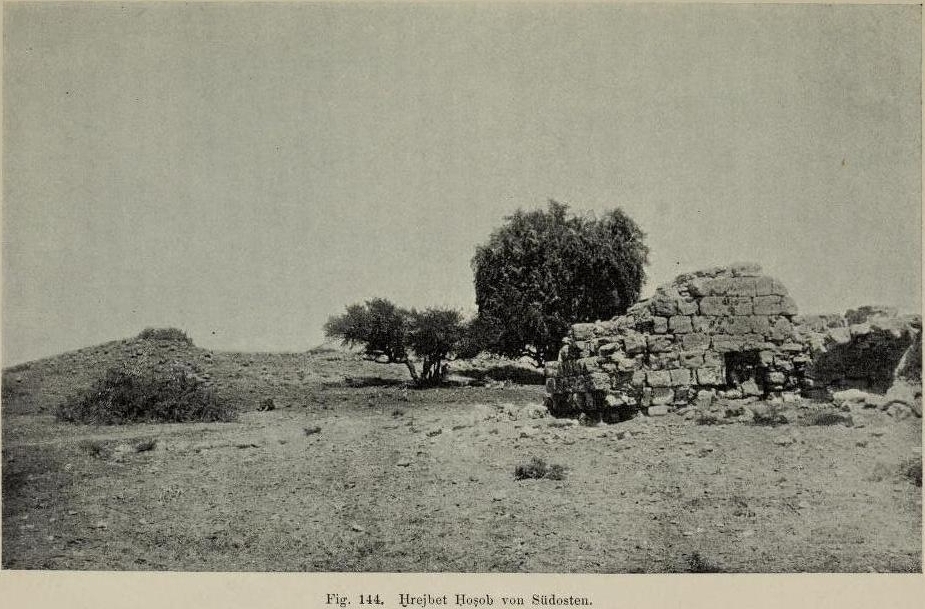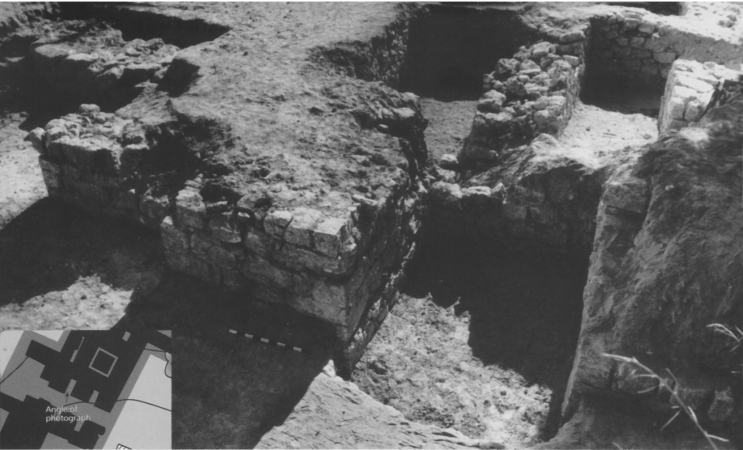|
Other Archaeological Sites / The Neolithic of the Levant (500 Page Book Online) Ancient Ein Haseva (Hatzeva) [Biblical Tamar] An Israelite Fortress on the Border with Edom
Overview: The oasis, identified as Biblical Tamar and Roman Tamara, is located in the Arabah valley. It receives its waters from the spring of Ein Hazeva. The frontier location, situated on the crossroads of major ancient routes, was a perfect place for a fortress and inn. Archaeological excavations have reconstructed a number of fortresses and installations dated to the Israelite Kingdom -- Nabatean -- Roman and Early Arab periods (4) Remains of several Israelite fortresses at Ein Hatseva are located on a low hill in the Arava Valley some 35 kilometres south of the Dead Sea. The spring (ein) -- a source of fresh water in this desert region -- and the strategic position of the hill at the intersection of the main Arava road and the Negev-Edom road were the reasons for the building of consecutive fortresses on this spot over the course of about 1000 years. Each fortress served as the military and administrative center for the region as well as a caravan station (1) ... The ruins of Hatseva had already been surveyed at the beginning of the century and identified as the Biblical Tamar and as the Roman Tamara (ibid) ... The site (Ain Husub) was first described by Alois Musil who arrived there in 1902 and documented the large jujube tree that stood there and sketched Mesad Hazeva, the nearby aqueducts and the trees next to the spring (2). Ezekiel 48:28: ... the border shall be even from Tamar unto the waters of strife in Kadesh ...
(3) The Fortresses at ˓En Ḥaṣeva by Rudolph Cohen in The Biblical Archaeologist (1994) Large scale excavations at ˓En Ḥaṣeva have provided one of the most important recent discoveries in the Arabah. Excavators have exposed a succession of fortresses -- from the Byzantine and early Islamic period to the Iron Age -- occupying this crucial crossroads of ancient commerce. In both Roman and Iron Age periods the Ḥaṣeva fortress was among the most immense in the region. Excavation is finally clarifying the true nature of the site which has been known and visited for over a century (3). As early as the nineteenth century researchers touring the area of ˓En Ḥaṣeva, one of the most abundant springs of the Arabah, noted remains beside the spring. Alois Musil visited the area in 1902 and prepared a sketch of the square fortress which had projecting corner towers. He saw an additional multi-roomed structure adjacent to the fortress in the south as well as the remains of a bathhouse in the east. Musil identified the fortress with the caravanserai (ibid).
United Israelite Kingdom Fortress Remains (Stratum 8)
Judean Kingdom (Strata 7a-7b)
An immense fortress, four times larger than the previous fortress, was built during the 9th or 8th Century BC (Iron age II -- the Israelite period). It included a casemate wall surrounding the large site (100m x 100m), 3 towers and a four chambers gate on the north side. Sections of the fortress were reconstructed by the archaeologists on all sides of the mound (Stratum 7b). The fortress was destroyed and blazed following the Assyrian conquest by Sennacherib (ibid).
Stratum 6 Fortress and Edomite Shrine (7th-6th Century BC)
Apparently this unusual collection can be ascribed to the end of the seventh or the beginning of the sixth centuries BCE and is apparently concurrent to the remains of the late Stratum 6 Iron Age fortress. We attribute this fortress to the reign of Josiah (639-609 BCE), the last period of efflorescence and expansion of the Judean monarchy before the Babylonian conquest. The smashing of the cult vessels may have been part of Josiahs religious reform (ibid).
The Nabataean Caravanserai (Stratum 5) 1st Century BC -- 1st Century AD
Hazeva was one of the stations on the road from the Nabatean capital city Petra to the ports of the Mediterranean Sea and also to the center and north of Israel. The archaeologists identified in Stratum 5 sections of a small Nabatean fortress -- temple and storage room under the ruins of the Roman fortress (4).
The Roman Fortress (Strata 3-4) 2nd-4th Century AD
The building of the Roman fortress at Ḥaṣeva occupied two clearly distinct stages. Stratum 4 offered a typical square fortress (castellum circa 46x46 metres) ... The Stratum 3 Roman fortress at Ḥaṣeva is the largest of its kind known in the Arabah (ibid). At the end of the third or the beginning of the fourth centuries during the reign of Diocletian the fort flourished once again. The projecting towers were added at that time (Stratum 3). This late Roman fortress was part of the Diocletian frontier system that depended principally on towers -- forts and fortresses erected along strategic roads. The inhabitants of the southeastem frontier of the Roman Empire, between the Euphrates and the Red Sea, were Arab tribes called Saracens who conducted razzia with the basic aim of taking booty from the merchants and travelers who crossed the desert areas and whose destination was important commercial and trade cities including Jerusalem and Gaza. The track south from Jerusalem would have first reached Elusa, continued on to Tamara (Ḥaṣeva) positioned south of the Dead Sea and led from there to Transjordan -- Rababatora and Philadelphia (ibid). The Roman fort fell into disuse during the second half of the fourth century CE perhaps as the result of the earthquake of 363 CE which destroyed Petra and several other sites. Over its remains Stratum 2 offered scanty and unidentifiable remnants including pottery of the sixth-seventh centuries CE (ibid).
The strategic importance of ˓En Ḥaṣeva-Tamara is obvious sitting as it does at the intersection of four major routes -- one leading south to Elath, one traveling east to Edom, a third leading north to Jerusalem and the fourth leading west through Ma‘aleh ‘Aqrabim to the central Negev area. The remains of the impressive fortresses testify to the importance of the site during the Iron Age and later in the Nabataean and Roman periods. Aharoni (See A Below) believed that the system of road-fortresses was established during the time of the First Temple period in the Negev and the Arabah. These
road-fortresses were to defend the kingdom and "to open up the trade routes
to the countries of the south". This has once again proved to
be right. Great economic importance
was attached to the control of these regions because of the profitable luxury-trade with Southern Arabia and East
Africa mentioned in the Bible. Biblical sources refer to the
building and maritime activities undertaken during the reigns of Kings Solomon, Jehoshaphat and Uzziah who
controlled Elath and Ezion-Geber. ˓En Ḥaṣeva was clearly a significant royal outpost
in the Arabah until its destruction at the
time of the destruction of the First Temple circa 586. Whether or not the
Edomites were partners with the Babylonians in this destruction remains a
question. (3).
In the Nabataean and Roman periods the importance of ˓En Ḥaṣeva increased following a prolonged abandonment lasting nearly 500 years. This points to the renewed strategic importance of the area as a whole at this time and suggests that the status of ˓En Ḥaṣeva again matched that attained during the First Temple Period. It is the massive plan of the Roman fortress at ˓En Ḥaṣeva in the third-fourth centuries CE which further identifies the site with Roman Tamara.
Excavations at the site have uncovered signs which indicate that it was
still occupied in the sixth-seventh centuries CE well after its fourth century
destruction, possibly because of the
earthquake of 363 CE (ibid).
The excavators identified the various levels of the site and marked them as Strata (level) 1-8 as summarized in the following table ... (Biblical Tamar -- Hazeva Fortress -- Ir Ovot) at BibleWalks.com
(1) The Israel Ministry of Foreign Affairs © 02 Feb 1999 on behalf of the Israel Antiquities Authority
(2) ‘En Hazeva by Yoram Haimi in Excavations and Surveys in Israel (IAA) 2016
(3) The Fortresses at ˓En Ḥaṣeva by Rudolph Cohen in The Biblical Archaeologist (1994)
(4) (Biblical Tamar -- Hazeva Fortress -- Ir Ovot) at BibleWalks.com
(5) The Iron Age Fortresses at ˓En Ḥaṣeva by Rudolph Cohen and Yigal Yisrael in the The Biblical Archaeologist (1995)
(A) Forerunners of the Limes: Iron Age Fortresses in the Negev by Yohanan Aharoni in the Israel Exploration Journal (1967)
‘En Hazeva -- Excavators: Rudolph Cohen and Yigal Israel -- © Israel Antiquities Authority
Arabia Petraea by Alois Musil (1907) Volume 2 Part 2 (Pages 202-208)
|



